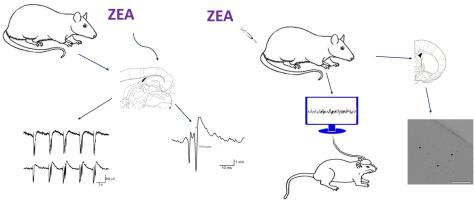NeuroToxicology ( IF 3.4 ) Pub Date : 2021-08-04 , DOI: 10.1016/j.neuro.2021.08.001 Veronika Bódi 1 , Vivien Csikós 2 , Tímea Májer 1 , Attila Tóth 1 , Árpád Dobolyi 2 , Ildikó Világi 1 , Petra Varró 1

|
Zearalenone (ZEA) is a mycotoxin produced by Fusarium species, detectable in various cereals and processed food products worldwide. ZEA displays a significant estrogenic activity, thus its main health risk is the interference with sexual maturation and reproduction processes. However, in addition to being key hormonal regulators of reproductive function, estrogenic compounds have a widespread role in brain, as neurotrophic and neuroprotective factors, and they may influence the activity of several brain areas not directly linked to reproduction, as well. Therefore, in the present study, acute effects of ZEA were studied on certain neuronal functions in rats.
Experiments were performed on rat brain slices or live rats. Slices were incubated in ZEA-containing (10–100 μM) solution for 30 min. Electrically evoked and spontaneous field potentials were studied in the neocortex and in the hippocampus. At higher concentrations, ZEA incubation of the slices altered excitability and the pattern of epileptiform activity in neocortex and inhibited the development of LTP in hippocampus.
For the verification of these in vitro results, in vivo electrophysiological and immunohistochemical investigations were also performed. ZEA was administered systemically (5 mg/kg, i.p.) to male rats and somatosensory evoked potentials and neuronal activation studied by c-fos expression were analyzed. No neuronal activation could be demonstrated in the hippocampus within 2 h of the injection. In the somatosensory cortex, ZEA did not change in vivo evoked potential parameters, but the activation of a small neuronal population could be demonstrated with the c-fos technique in this brain area. This result could be associated with the ZEA-induced alteration of epileptiform activity observed in vitro.
Altogether, the toxin altered the excitability and plasticity of neuronal networks after direct treatment in slices, but the effects were less prominent on the given brain areas after systemic treatment in vivo. A probable explanation for the partial lack of in vivo effects may be that after a single injection, ZEA did not cross the blood-brain barrier at sufficient rate to allow the build-up of comparable concentrations in the investigated brain areas. However, in case of compromised blood-brain barrier functions or long-term repeated exposure, alterations in cortical and hippocampal functions cannot be ruled out.
中文翻译:

玉米赤霉烯酮在急性体外暴露后改变大鼠神经元网络的兴奋性
玉米赤霉烯酮 (ZEA) 是一种由镰刀菌产生的霉菌毒素,可在世界各地的各种谷物和加工食品中检测到。ZEA 表现出显着的雌激素活性,因此其主要的健康风险是干扰性成熟和生殖过程。然而,除了作为生殖功能的关键激素调节剂之外,雌激素化合物在大脑中具有广泛的作用,作为神经营养和神经保护因子,它们也可能影响与生殖不直接相关的几个大脑区域的活动。因此,在本研究中,研究了 ZEA 对大鼠某些神经元功能的急性影响。
在大鼠脑切片或活大鼠上进行实验。切片在含有 ZEA(10–100 μM)的溶液中孵育 30 分钟。在新皮质和海马中研究了电诱发和自发场电位。在较高浓度下,切片的 ZEA 孵育改变了新皮质中的兴奋性和癫痫样活动模式,并抑制了海马中 LTP 的发展。
为了验证这些体外结果,还进行了体内电生理学和免疫组织化学研究。对雄性大鼠全身施用 ZEA (5 mg/kg, ip),分析通过 c-fos 表达研究的体感诱发电位和神经元活化。注射后 2 小时内,海马体中未显示神经元激活。在体感皮层中,ZEA 没有改变体内诱发电位参数,但在该脑区使用 c-fos 技术可以证明小神经元群体的激活。该结果可能与体外观察到的 ZEA 诱导的癫痫样活动改变有关。
总之,该毒素在切片直接处理后改变了神经元网络的兴奋性和可塑性,但在体内全身治疗后,对给定脑区的影响不太明显。部分缺乏体内效应的一个可能解释是,在单次注射后,ZEA 没有以足够的速度穿过血脑屏障,从而无法在所研究的大脑区域中积累相当的浓度。然而,在血脑屏障功能受损或长期反复暴露的情况下,不能排除皮质和海马功能的改变。









































 京公网安备 11010802027423号
京公网安备 11010802027423号